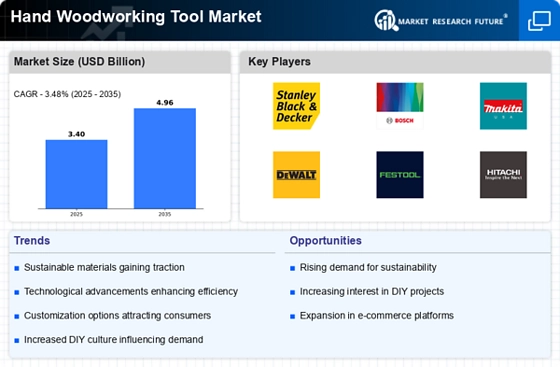Growth of Online Retail Channels
The Hand Woodworking Tool Market is witnessing a significant shift towards online retail channels. With the proliferation of e-commerce platforms, consumers now have easier access to a wide range of woodworking tools. This trend is particularly advantageous for niche products that may not be readily available in physical stores. Data indicates that online sales of hand woodworking tools have increased by approximately 30% in the past year, reflecting changing consumer shopping habits. The convenience of online shopping, coupled with the ability to compare prices and read reviews, is driving this growth. As more consumers turn to digital platforms for their woodworking needs, the Hand Woodworking Tool Market is likely to expand its online presence to capture this burgeoning segment.
Increased Demand for Customization
The Hand Woodworking Tool Market experiences a notable surge in demand for customized tools. As consumers increasingly seek personalized woodworking solutions, manufacturers are adapting their offerings to meet these preferences. This trend is particularly evident among hobbyists and professional woodworkers who desire tools tailored to their specific needs. The customization aspect not only enhances user satisfaction but also fosters brand loyalty. Market data indicates that the customization segment is projected to grow at a compound annual growth rate of approximately 5% over the next five years. This growth reflects a broader shift towards individualized products in the Hand Woodworking Tool Market, where consumers are willing to invest in tools that align with their unique woodworking styles.
Rising Interest in Sustainable Practices
Sustainability is becoming a central theme in the Hand Woodworking Tool Market. As environmental awareness grows, consumers are increasingly seeking tools produced through sustainable practices. This includes the use of responsibly sourced materials and eco-friendly manufacturing processes. Market Research Future indicates that products labeled as sustainable are experiencing a sales increase of around 15% annually. This trend is not only beneficial for the environment but also appeals to a demographic that prioritizes ethical consumption. Manufacturers are responding by developing tools that align with these values, thereby enhancing their market position. The Hand Woodworking Tool Market is likely to see continued growth in this area as sustainability becomes a key purchasing criterion for consumers.
Expansion of Educational Programs and Workshops
The Hand Woodworking Tool Market is benefiting from the expansion of educational programs and workshops aimed at woodworking enthusiasts. As more individuals seek to learn woodworking skills, the demand for quality hand tools is on the rise. Community colleges, craft schools, and online platforms are increasingly offering courses that teach woodworking techniques, thereby fostering a new generation of woodworkers. Market data suggests that enrollment in such programs has increased by 20% over the past year, indicating a growing interest in the craft. This influx of new woodworkers is likely to drive demand for hand tools, as participants seek reliable and effective tools to apply their newly acquired skills. Consequently, the Hand Woodworking Tool Market stands to gain from this educational trend.
Technological Advancements in Tool Manufacturing
Technological advancements play a pivotal role in shaping the Hand Woodworking Tool Market. Innovations in materials and manufacturing processes have led to the development of more efficient and durable tools. For instance, the introduction of advanced alloys and composites has enhanced the performance and longevity of hand tools. Additionally, the integration of smart technology into traditional tools is gaining traction, allowing for improved precision and ease of use. Market analysis suggests that the adoption of these technologies could lead to a 7% increase in market value over the next few years. As manufacturers continue to invest in research and development, the Hand Woodworking Tool Market is likely to witness a transformation that caters to the evolving needs of woodworkers.


















Leave a Comment